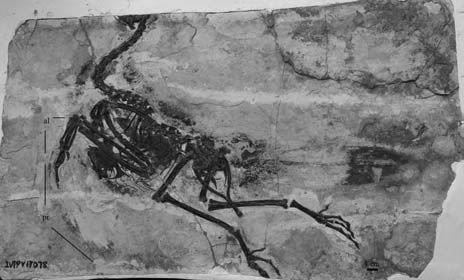The Lower Cretaceous Jehol Group in northeastern China has yielded the world’s greatest wealth of exceptionally well-preserved early birds. More than 30 bird taxa have been reported from the Jehol Group – approximately one-third of the known global diversity of Mesozoic birds. In a study published online August 28 in Historical Biology (2013), Dr. ZHOU Zhonghe, Institute of Vertebrate Paleontology and Paleoanthropology (IVPP), Chinese Academy of Sciences, and his team described a new species of basal ornithuromorph bird, Piscivoravis lii gen. et sp. nov., based on a new specimen preserving macerated fish remains recently collected from the Lower Cretaceous Jiufotang Formation near Xiaotaizi village, Jianchang, Liaoning Province of China. The new specimen preserves several unique anatomical features previously unreported in Early Cretaceous ornithuromorphs, helping us better understand the early diversification of Ornithuromorpha with respect to character evolution and diet.
Ornithuromorpha, the clade that includes living birds, is the most derived group in the Lower Cretaceous. Piscivoravis lii is a subadult individual represented by a nearly complete, articulated skeleton missing the cranium, preserving an organic outline of the body, food remains preserved in the abdominal area and ventral to the dentary and impressions of the wing and tail feathers.
Phylogenetic analysis indicates that Piscivoravis is more derived than Archaeorynchus, but in a basal polytomy with Jianchangornis, Patagopteryx, and the clade including all more derived ornithuromorphs. The preserved wing and tail feathers provide new information on feather diversity and evolution in Early Cretaceous ornithuromorphs.
The new specimen preserves the macerated remains of fish in two places of the body. A small cluster of fish bones is present near the dentary, and approximately four to five vertebrae and a few ribs are visible. The fish bones are not in articulation but form an oval cluster measuring 13 mm by 8 mm. A much larger cluster of fish bones including some fin rays and some larger fragments is located in the abdomen, laterally overlain by the thoracic ribs and uncinate processes. The fish bones have tentatively been identified as belonging to a primitive teleost fish.
Several features suggest that Piscivoravis had a predominantly terrestrial ecology: metatarsal III longest; and its distally trochlea in a single plane with II and IV; proximal pedal phalanges longer than the distal ones and pedal unguals weakly curved. Researchers propose that Piscivoravis may have lived in a terrestrial, near lakeshore environment and primarily fed on fish.
"The preservation of fish bones ventral to the dentary and in the stomach provides direct evidence that the new species was piscivorous – previously only reported in Yanornis, and as in some living birds, and it was capable of moving food bidirectionally through the alimentary canal”, said ZHOU Shuang of the IVPP, first author of the study. The study was supported by the National Basic Research Program of China (973 Programme) and the National Natural Science Foundation of China.

Fig.1 Photo of the holotype of Piscivoravis lii gen. et sp. nov. (IVPP V 17078). Scale bar equals 1 cm.(Image by ZHOU Shuang)
 Fig.2 Detail photograph (A) and line drawing (B) of the food remains preserved in the abdominal cavity of Piscivoravis lii. Scale bar equals 5mm.(Image by ZHOU Shuang)
|

